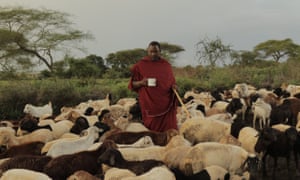Edward Loure wins leading environmental award after helping communities in Tanzanian Rift Valley secure legal title to ancestral land
The Tarangire national park in Tanzania is known for its vast concentrations of wildlife in the dry season, the spectacular annual migrations of its elephants, wildebeest and zebra, and its majestic old baobab trees.
But few people who visit it realise that the 1,100 sq mile park was, until colonial times, widely used by pastoralists and hunter-gatherers, or that many of the new tourist lodges built around it are situated on ancestral lands “grabbed” by government or companies, without compensation, to stimulate money-spinning tourism.
For Maasai leader Edward Loure, the loss of his family land from what is now Tarangire park was a catalyst to get all ancestral land in the Tanzanian Rift Valley legally protected from land-hungry companies, tour operators and others. Working with the Ujamaa community resource team (UCRT) – one of the first tribal-led NGOs in Tanzania – more than 200,000 acres now has full protection; a further 800,000 acres will follow in the next year.
Loure, who has won a Goldman environmental prize for reconciling the competing needs of development and wildlife, identified an innovative legal mechanism that grants land rights to entire communities rather than to individuals, and was the first person to establish certificates of customary right of occupancy (CCROs).
Giving communities legal title to land is, he says, the key to reducing human-wildlife conflicts and stimulating sustainable development in rural Tanzania. Without it, land is continually fought over and safari companies and multinationals have been able to take what they want. With legal title, the different needs of conservation and pastoralism can be met and indigenous people can coexist with conservation and settled communities, he says.
Loure’s new model for conservation and development has been widely welcomed, because it can be adopted throughout Tanzania and beyond.
“People had no legal documents, no security,” he says. “Nothing was documented. We had to make sure people had security. Many villages had lost huge amounts of land and received no compensation. Now they can show that the land belongs to them. Until now, government or anyone could claim that it was not owned by anyone and do what they want.”
But it has required a shift in perception to have customary rights recognised both by government and communities, he says. “It’s a case of everyone seeing that land belongs to the community as much as the individual. It’s saying ‘our land’ rather than ‘my land’. So many companies have come and there has been a lot of land grabbing going on. But we have shown that if we use resources well there is enough for everyone.
“Pastoralist and hunter-gatherer livelihoods must be recognised as important and not seen as a brake on development. They are often dismissed.”
Land in Tanzania has been bitterly fought over since colonial times, with successive governments evicting pastoralists and hunter-gatherer communities from many areas to establish national parks, game reserves and large-scale farming. The Maasai were forced to leave the Serengeti to create the national park in the early 1950s, and the Barabaig forced from the Basotu plains for wheat farming in the early 1970s. The result was severe disruption to customary land tenure and land management practices.
One of the beneficiaries of the new customary rights are the Hadzabe tribe, who have lived in this region for more than 40,000 years but are now reduced to 1,200. “Without land rights, these communities would face extinction,” says Loure.
“Maasai and Hadzabe tribes can now continue to live sustainably on their ancestral lands where CCROs have been established; some Hadzabe CCROs have also formed successful partnerships with Carbon Tanzania, receiving carbon credits to help pay for schools and medical care.”


No comments:
Post a Comment